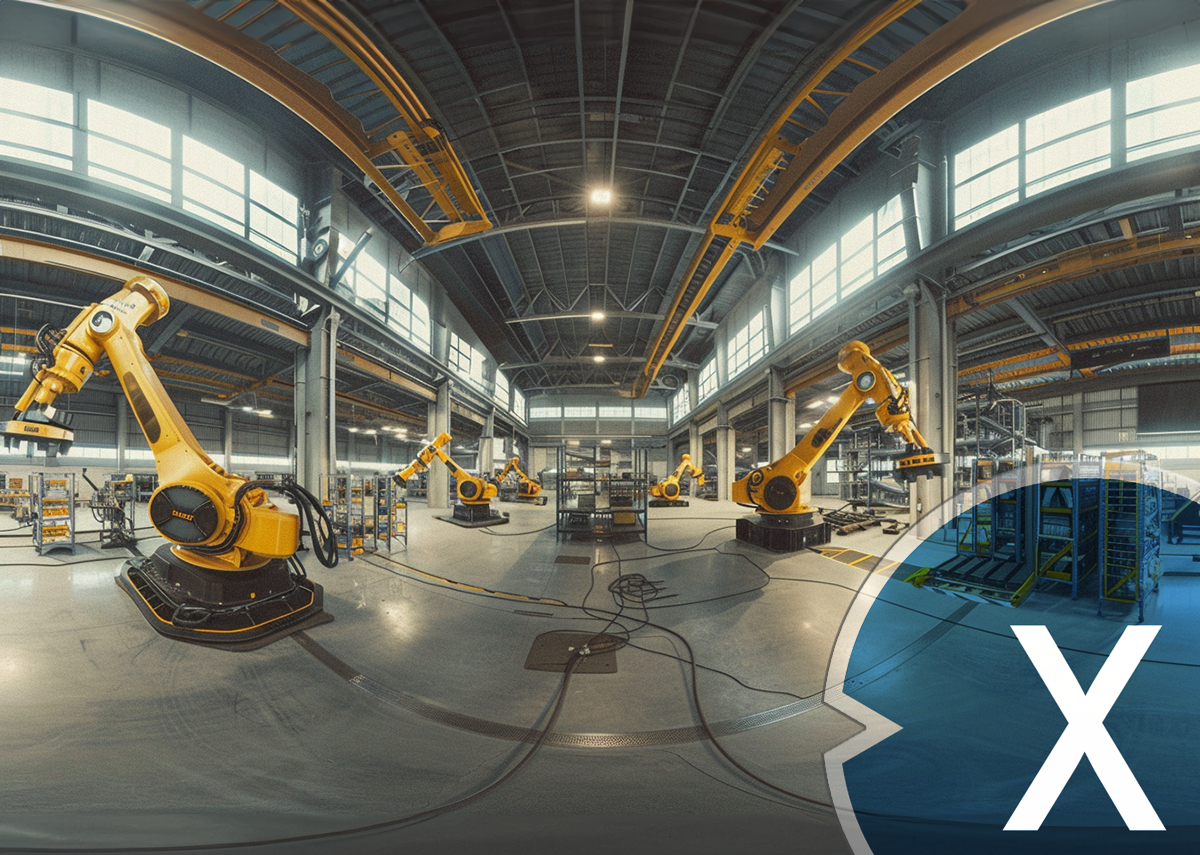
Skills shortage? Cost pressures? Digitalization? Automation through robotics offers the solution – Image: Xpert.Digital
🔧 Leveraging automation potential: Smart robotics solutions from Ulm for SMEs
🤖✨ Many small and medium-sized enterprises still rely on manual processes for various work steps. However, intuitive and affordable robotics now offers significant automation potential in these areas as well, opening up new opportunities for increasing efficiency and reducing costs. A revolutionary robotics solution platform from Ulm provides the ideal foundation for this.
1. 🗂️ Planning
Careful planning is the foundation of every successful robotics application. This is where the planning tool comes in – a digital planner for robotics applications. With this tool, companies can visualize and simulate their ideas in 3D and evaluate the economic viability of their concepts. The digital planning tool supports users from the initial design to the detailed development and planning of their robotics solution. Thanks to pre-built templates, customized applications can be created quickly and efficiently without requiring extensive prior knowledge.
2. 🛠️ Assemble
After planning comes the next step: assembling the necessary components. A specialized sourcing portal helps find the right parts for each specific application. With just a few clicks, companies receive customized offers without having to navigate the often confusing robotics and automation market. This not only saves time but also significantly reduces the complexity of the procurement process.
3. 🚀 Start and get going
The next milestone is the actual commissioning of the robotics application. This is where the Builder comes in, a universal and vendor-independent tool that enables the setup and commissioning of the application. At the heart of the Builder is a low-code development environment that is easy to use even for users without specific technical knowledge. This eliminates the need for traditional programming, making the commissioning of robots as intuitive and simple as creating presentations in PowerPoint.
🧰 Areas of application
The applications for modern robotics are diverse, ranging from machine tending and material handling to palletizing and dispensing. Other important areas of application include material removal, assembly, transport with mobile robots, and quality control. This wide range of applications illustrates the enormous potential that robotics can unleash in various sectors.
🏭 Industries
Robots make a crucial difference in various industries. In industrial manufacturing, the automotive industry, and the supplier industry, they enable precise and efficient production processes. They are also indispensable in contract manufacturing, metal and plastics processing, and electronics production. The semiconductor and photovoltaic industries, in particular, are increasingly relying on robotics to optimize production processes and ensure quality. In medical technology and pharmaceutical production, robots ensure sterile and precise work, while in the packaging and aerospace industries, they take on highly complex and specialized tasks. Companies in the biotech, robotics, and logistics sectors also benefit considerably from the diverse applications of robotics.
🏗️💵📚 Opportunities and Challenges
The introduction of robotics undoubtedly brings many advantages. Besides the obvious increase in productivity, companies can also reduce costs by making workflows more efficient and decreasing their reliance on manual labor. At the same time, robots offer the possibility of performing tasks under extreme conditions that could be dangerous or harmful to human health.
Despite its potential, robotics also presents challenges. Integrating robotics into existing systems requires a certain initial investment and an adjustment of work processes. Furthermore, employees need appropriate training to operate the new technologies. This can be a particular hurdle for small and medium-sized enterprises (SMEs). However, the intuitive and user-friendly design of modern robotics platforms offers a significant advantage here, as it considerably simplifies the transition to robotics.
💡 Continuous development
The continuous development of robotics and automation technologies promises an exciting future. The trend is toward increasingly intelligent and autonomous systems, further enhanced by artificial intelligence and machine learning. These systems are able to learn from their experiences and continuously optimize themselves, leading to even more efficient and precise workflows.
Furthermore, collaboration between humans and robots (so-called cobots) opens up new possibilities. Cobots are designed to work side-by-side with human colleagues and support them in their tasks, rather than replacing them. This collaboration can lead to a significant increase in efficiency and productivity, while simultaneously improving employee safety and well-being.
🌐 Automation through robotics
Automation through robotics represents a promising solution for many companies to successfully address the challenges of skilled labor shortages, cost pressures, and digitalization. With proper planning, targeted component selection, and user-friendly commissioning, companies can leverage the full potential of robotics and sustainably enhance their competitiveness. The diverse applications and wide range of industries in which robotics can be deployed impressively demonstrate that this technology is not merely a passing trend, but rather has a firm place in the future of industrial production, medical technology, logistics, and many other sectors. Companies that invest in this technology early on and train their employees accordingly will reap the long-term benefits of automation.
📣 Similar topics
- 🤖 Intuitive robotics for SMEs: New efficiency potentials
- 🔧 Revolutionary robotics platform from Ulm: Automation made easy
- 💡 From planning to implementation: Robotics in SMEs
- 🚀 Efficiency and cost reduction through robotics applications
- 🏭 Robotics in various industries: Versatile applications
- 📊 Planning tools and assembly aids for SMEs
- 🌐 Robotics is revolutionizing the automotive and supplier industries
- 🤖 The future of robotics: opportunities and challenges
- 💼 Cobots: Human-robot collaboration in SMEs
- 🏭 Industry diversity through robotics: From medicine to logistics
#️⃣ Hashtags: #Robotics #Automation #SMEs #Efficiency #Future
🔄🛠️ Cobots (collaborative robots) 🤖 and autonomous mobile robots (AMRs)
Flexible and modular logistics such as intralogistics: Flexible and modular conveyor systems - cobots (collaborative robots) and autonomous mobile robots (AMRs) - Image: Xpert.Digital
Flexibility in intralogistics is significantly increased through the use of modular conveyor systems, collaborative robots (cobots) and autonomous mobile robots (AMRs). These technologies transform traditional warehouse and production environments and help companies make their processes more efficient and economical.
More about it here:
📌 Other suitable topics
🤖✨ Intuitive Robotics: Harmonious interaction between humans and machines
🤖✨ Intuitive robotics refers to technologies and control systems designed to make human-robot interaction as simple and natural as possible. The goal is for people to be able to operate and interact with robots without requiring extensive technical training or specialized knowledge. Here are some core concepts and technologies often associated with intuitive robotics:
🗣️ Natural User Interfaces (NUI)
These include interfaces that interact naturally with the user, for example through speech, gestures, or touch. Voice control systems are one example, allowing the user to give commands to a robot, similar to a conversation with a human.
🧠 Artificial Intelligence (AI) and machine learning
By using AI, robots can better understand their environment and react to changes. They can learn from experience and continuously improve their performance, which makes interacting with them easier.
📸 Visual recognition and sensors
Advanced cameras and sensors enable robots to monitor and react to their environment in real time. This can aid navigation in complex environments and make collaboration with humans safer and more effective.
🖐️ Haptic feedback
This technology allows users to receive tactile feedback from robots, similar to touching a physical object. This can be particularly useful in areas such as teleoperation or remote control of robotic arms.
🖥️ User-friendly programming environments
To lower the barrier to programming and configuring robots, there are graphical programming interfaces or no-code/low-code platforms that allow even non-technical people to program and customize robots.
🤝 Collaborative robots (cobots)
These robots are specifically designed to work safely and harmoniously with humans. They are usually more compact, easier to operate, and have extensive safety features.
Intuitive robotics aims to make robotics accessible to a wider user group and to use it in a variety of applications – from industrial automation to personal service robots.
📣 Similar topics
- 🤖 Intuitive Robotics: Natural Human-Machine Interaction
- 🧠 AI and machine learning in intuitive robotics
- 📸 Visual recognition and sensor technology in intuitive robots
- 🖐️ Haptic feedback in intuitive robotics
- 🖥️ User-friendly programming environments for robots
- 🤝 Collaborative robots (cobots) for harmonious cooperation
- 💡 Key technologies of intuitive robotics
- 🔍 Sensors and perception for intelligent robots
- 🗣️ Intuitive voice and gesture control for robots
- 🌐 Intuitive robotics: Simple and accessible for all users
#️⃣ Hashtags: #IntuitiveRobotics #HumanMachineInteraction #AIandMachineLearning #SensorsAndPerception #UserFriendlyProgramming
🎯🏭 Definition and distinction between 'SMEs' and 'medium-sized businesses' in Germany
🌟 The terms “SMEs” (small and medium-sized enterprises) and “Mittelstand” are often used synonymously, but there are some differences in their meaning and use, especially in Germany.
✨ SMEs (Small and Medium-sized Enterprises)
SME is a formal classification often based on quantitative criteria such as number of employees, revenue, and balance sheet total. The exact definition can vary depending on the country and context.
In the EU, SMEs are typically defined as follows:
Small businesses
Up to 50 employees and either an annual turnover or an annual balance sheet total of up to 10 million euros.
Medium-sized companies
Up to 250 employees and either an annual turnover of up to 50 million euros or an annual balance sheet total of up to 43 million euros.
🌍 Small and medium-sized enterprises
The term "Mittelstand" (middle class) is more of a socio-economic concept and less strictly defined.
Traditionally, the Mittelstand (SME sector) comprises family-run businesses that often have strong local or regional roots, regardless of their size in the classical sense.
Medium-sized businesses are often associated with certain qualitative characteristics, such as a long-term orientation, high personal responsibility of the owners, and a strong connection to employees and location.
🔧🤝 SMEs and medium-sized businesses
While SMEs are based on formal, quantitative criteria, the term "Mittelstand" (medium-sized businesses) tends to be a broader, more qualitative description of the business world. A company can therefore be an SME without necessarily being a typical Mittelstand company, and vice versa.
📣 Similar topics
- 🤝 The middle class: A socio-economic perspective
- 🌐 Medium-sized businesses: Local roots and family management
- 🔍 SMEs vs. Medium-sized businesses: Differentiation and similarities
- 📚 Qualitative aspects and traditional values of medium-sized businesses
- 💼 Formal criteria for SMEs and the broader concept of medium-sized businesses
- ⚖️ Classification of companies: SME criteria and concepts for medium-sized businesses
#️⃣ Hashtags: #CompanySize #MediumSmall ..
We are there for you - advice - planning - implementation - project management
☑️ SME support in strategy, consulting, planning and implementation
☑️ Creation or realignment of the digital strategy and digitalization
☑️ Expansion and optimization of international sales processes
☑️ Global & Digital B2B trading platforms
☑️ Pioneer Business Development
I would be happy to serve as your personal advisor.
You can contact me by filling out the contact form below or simply call me on +49 89 89 674 804 (Munich) .
I'm looking forward to our joint project.
Xpert.Digital - Konrad Wolfenstein
Xpert.Digital is a hub for industry with a focus on digitalization, mechanical engineering, logistics/intralogistics and photovoltaics.
With our 360° business development solution, we support well-known companies from new business to after sales.
Market intelligence, smarketing, marketing automation, content development, PR, mail campaigns, personalized social media and lead nurturing are part of our digital tools.
You can find out more at: www.xpert.digital - www.xpert.solar - www.xpert.plus

